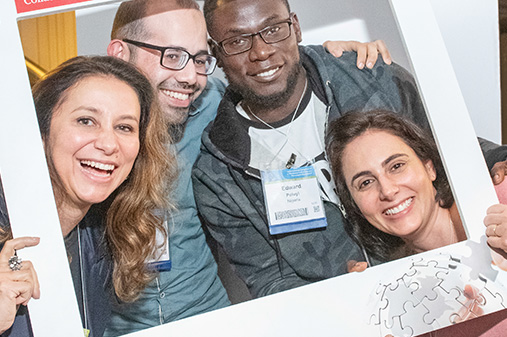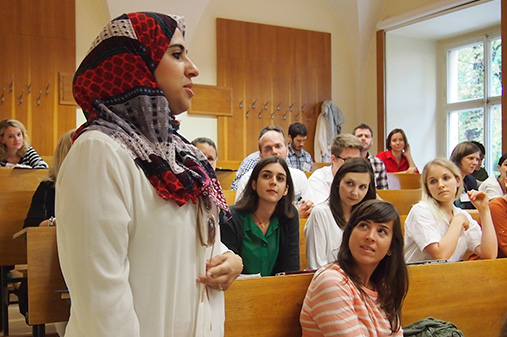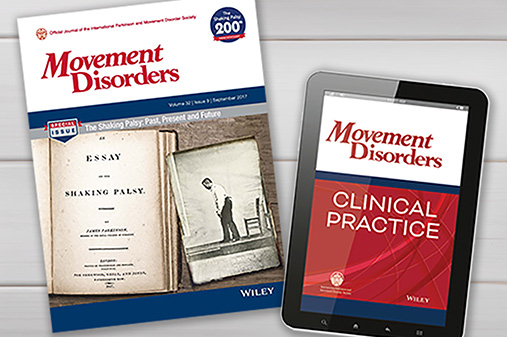Artificial intelligence in the diagnostic approach of chronic ataxias
Journal CME is available until May 21, 2026
Read the article.
Dr. Hugo Morales Briceno: Welcome to the MDS Podcast, the official podcast of the International Parkinson's and Movement Disorder Society. I'm your host Hugo Morales. In today's episode, we delve into chronic ataxia. A group of genetically diverse, often lucid disorders posing a diagnostic challenge to many neurologists as access to genetic testing varies globally.
View complete transcript
Could artificial intelligence be the game changer? In this episode, we explore the development of the first AI powered virtual assistant designed to support clinicians in diagnosing chronic ataxia, offering a promising step forward in regions with limited access to specialized care. Today I have the pleasure of interviewing Dr. Lucas Alessandro and Malco Rossi the first and senior authors of the paper, Artificial intelligence [00:01:00] based virtual assistant for the diagnostic approach of chronic ataxias, published online in March, 2025 in Movement Disorder Journal. Welcome Lucas and Malco. Thank you for coming today. Now I'm gonna start with one question that is relevant and I found this study very interesting.
So can you walk us through the study's design and what was the project and objectives of this study?
Dr. Lucas Alessandro: Yes, of course. Thank you very much for the opportunity to share our work. First, it's important to understand that this apporach was inspired by a one hour issue, rather disease is a big challenge in the medical practice. Neurology plays a central role in this condition as neurological causes account for more than half of cases.
Reaching a diagnosis is often a long and difficult process. It can take years and usually requires consultation [00:02:00] with multiple specialists. And diagnosis errors are also common, so these factors are considered a strain on healthcare system. Especially in low resource country like Argentina and other parts of Latin America.
For several years, I have been developing artificial intelligence tool to support neurological diagnosis. I convinced that the, this kind of technology can help address many of the structural barriers we face in the region. We choose to begin with ataxia because they present to a strong opportunity to demonstrate how an AI tool can be designed and validate for a specific complex clinical challenge.
In this case, helping clinician make diagnosis decision.
Dr. Malco Rossi: Yes. What Lucas is pointing out is extremely relevant in the ataxia field. Chronic ataxia are a complex group of [00:03:00] over 300 diseases, most of them of genetic cause, and they have significant diagnostic challenges in our clinical practice because of the very high clinical and etiological heterogeneity. So we were wondering if artificial intelligence could help the neurologist, as we are in the diagnostic approach of chronic ataxia. Considering the large list of differential diagnosis and complementary studies available, including different genetic test methodologies such as exome or genome sequencing or tests to diagnose repeat expansion disorders. So currently there is no single genetic method available in routine clinical practice that includes all genetic ataxia.
Requiring the repeat expansion detection methods for most of the common autosomal dominant cerebral ataxias and exome sequencing for most of the [00:04:00] autosomal recessive cerebellar ataxias. But access to genetic testing is not universal and important barriers to access to genetic testing still exist in several regions.
In addition, many regions of the world. Lack access to neurologist or specialist care of ataxia. So having a tool that helps in the diagnostic process of complex and diverse causes of ataxia could potentially improve diagnostic performance in such a setting. Considering these challenges, the aim of the study was to develop and validate the first AI powered virtual assistant.
With the clinical purpose of assisting in the diagnostic process of chronic ataxia, and that could be used in commonly used messaging apps.
Dr. Hugo Morales Briceno: And then, can you walk us through the study's design and what was the project's aim and [00:05:00] objectives?
Dr. Malco Rossi: Yes. So considering these challenges, the aim of the study was to develop and validate the first AI powered virtual assistant with a clinical purpose of assisting in the diagnostic process of chronic ataxias by the use of a messaging app. To do this, we can divide our work in two steps or phases, the development and the validation phases.
So first, to develop the virtual assistant tool, we created decision trees with more than 200 different question passed. To guide users through a series of questions based on their answers and ending in one of 107 possible outcomes. The tool does not create new content. Instead, it answers questions by extracting information from a database. So we created a database for chronic ataxias with clinical information of these disorders that [00:06:00] we obtained from medical sources like gene reviews, OMIM, Orphanet, and scientific articles. The database covers 151 diseases where ataxia is a major symptom. Second, to validate the virtual assistant, we selected 453 clinical cases from several publications.
These cases had not been used when building the system database. From each case, we collected data of demographic and clinical features. This information was used to compare how well the virtual assistant performed in comparison to chat GPT-4 and a group of 21 experienced neurologists from Argentina and other countries in Latin America. To simulate real patients, four medical students used a virtual assistant, so each student was given a random set of case summaries and answered the [00:07:00] assistant's questions as if they were patients. The assistant then provided possible diagnosis. Meanwhile, Chat GPT-4 under the 21 neurologist were given the exact same clinical summaries and were asked to list possible differential diagnosis. Neurologist could use any books or resources they wanted, just not AI tools. The goal was to make this test as realistic as possible, mimicking how physicians or neurologists usually obtain clinical information from patients interviews and exams.
Dr. Hugo Morales Briceno: Thank you Malco for detailing the study's design, which is very interesting. And moving to the results of your study, you found that the AI powered visual assistant outperformed both experts, neurologists and GPT-4 in diagnostic chronic ataxia. Can you help us to understand what made this [00:08:00] assistant so accurate and even slightly better than GPT-4, a large language model?
Dr. Lucas Alessandro: Excellent question. Thank you very much for asking it. First, it's important to note that the comparison with GPT-4 was conducted in 2023. Since then, this type of technology has advanced significantly in very short time. That said, the system is strong, performance lies in its design and unlike GPT-4, which is a generative model.
Our system is built on structured decision tree architecture. It's include more than 200 refined branches and about 100 terminal nodes. This structure enables the assistant to as consistently relevant and well organized question based on specific clinical signs and symptoms. Because it's focused, restrict and optimized for a single clinical area, in this case, ataxia.
It's performed much more reliably [00:09:00] than general propulsion. The models like GPD four when you in a specific diagnosis context,
Dr. Malco Rossi: In fact, both groups of neurologists and G PT four produced over 100. Incorrect diagnosis, most of them were made by GPT-4 that also created seven data hallucinations. This highlights the importance of using G PT four and other similar generative and non-validated AI tools with caution. We also have the need to verify the accuracy of these AI tools in routine clinical practice.
In contrast, the virtual assistant that we developed and validated was specifically designed to provide differential diagnosis for chronic attacks only. It does not provide differential diagnosis for disorders, not related with ataxia. As a result, it does not produce [00:10:00] data hallucinations and is more predictable.
So our virtual assistant is highly accurate because it provides a larger list of differential diagnosis in comparison to neurologists and GPT-4. But the instructions that neurologists and the prompt given to GPT-4 were clear that there was no limit on the number of diagnosis they could suggest.
Even though most of the differential diagnosis provided by the virtual assistant neurologist or GPT-4 were incorrect. Situation of many incorrect diagnosis mirrors real life clinical practice where physicians often consider multiple possibilities with none or most, at most, one being correct. So we are currently working on an improved version that will be more specific by providing a much limited list of differential diagnosis, and [00:11:00] it will also incorporate data from complementary studies.
Dr. Hugo Morales Briceno: Thank you very much Malcolm Lucas for giving us details about what made. The virtual assistant, so powerful and how we can understand how it's working. Now can, I'll ask you another question, which is important in terms of how we gonna use this technology with the assistant delivering results within a few minutes on average.
How do you envision this tool being integrated into clinical practice, especially in settings with limited access to movement disorder specialists? So what are your plans to bring this to the clinic?
Dr. Lucas Alessandro: That's a key question. I truly believe that technology is involving at an incredible fast pace. If we look back, medical knowledge [00:12:00] was initially passed down almost internally through the oral teaching of mentors. Later that it's begin to spread through traditional Medical textbook and more recently through scientifical articles.
Just a few years ago, access to information started to rely heavily on search engines and large medical databases. Today without a doubt artificial intelligence is emerging as the measure tool to support clinical decision making. It is very likely that once the necessary validation process are complete, this technology will be used in real time as a regular and reliable part of everyday medical practice.
Dr. Malco Rossi: I would like to add that incorporating AI based tools into movement disorder clinics. Can expand the range of differential diagnosis in patients with complex phenotypes, especially given that phenotype, [00:13:00] genotype correlations in neurology are often non-linear, but it's very important that clinicians use AI tools such as our virtual assistant or language models like GPT-4 as support and guidance rather than replacement for clinical judgment.
I think that caution is warranted when using tools like GPT-4 for diagnostic purposes because of some key limitations. For example, there is a lack of clear scientific rationale for some suggested diagnosis. There can be potential data hallucinations and generative AI based tools are not consistent over time.
These issues may be addressed by means of improved tools such as our validated virtual assistant, which provides evidence-based differential diagnosis and relevant literature for each case. So regarding your question on the role of the virtual assistant in settings with limited access to [00:14:00] specialists.
Our virtual assistant has particular utility in regions with limited access to specialists or without genetic diagnostic testing possibilities. So by narrowing the differential diagnosis, it supports a sequential cost-effective testing strategy, especially for repeat expansion disorders. This approach helps clinicians give priority which conditions to test for first, especially in resource limited settings.
Another point that I would like to comment on is that we followed a development and validation process for a virtual assistant that is scalable to other diseases. We think that similar AI-based tools could be designed for other neurological or systemic diseases. Also, we would like to make clear again that our virtual assistant is not in intended to [00:15:00] replace genetic testing or specialist evaluation.
It's just a supportive tool designed to guide the clinical diagnostic process, especially the selection of ancillary tests, and to compliment, but not to replace the expertise of neurologists and movement disorders specialists. So in summary. We developed and validated a fast user-friendly and highly accurate AI-based virtual assistant that supports the diagnostic evaluation of chronic ataxia, especially in settings with limited access to specialist or genetic testing.
Dr. Hugo Morales Briceno: An amazing amount of work you guys have done. Just amalgamating the literature and developing this algorithm and astutely using AI to understand how can clinicians diagnose chronic ataxias better. That's very interesting. That concludes our episode, and thank you Lucas and Malco for giving your insights on the promising value of [00:16:00] AI in assisting clinicians in the diagnosis of chronic at attacks.
Now stay tuned for our next episode where we will continue exploring the latest advancements in moving disorders. Until then, stay curious and keep learning.
[00:17:00]

Malco Rossi, MD, PhD
Fleni, Buenos Aires, Argentina

Lucas Alessandro, MD
Entelai, Argentina
Fleni, Buenos Aires, Argentina









